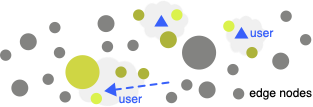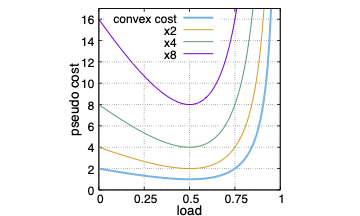Member: Kenjiro Cho, Hajime Tazaki, Jean-Francois Baffier
Category: Innovating
Tags: edge computing, autonomous resource management, convex cost function, cloud morphing
- Background:
- iijlab needs a research vision that unites the directions of different research projects
- our concept of distributed clouds should develop into specific models
- Purpose:
- provide a vision for future distributed autonomous clouds
- propose cloud-morphing architecture with a simple model
Cloud Morphing
- dynamically morphing clouds, following usage patterns
- micro services over distributed heterogeneous resources
- an interactive job follows the user
- a data-intensive job stays close to data
- services are inherently fault-tolerant, disaster-resilient
- micro services over distributed heterogeneous resources
- cost based resource management model
- convex cost function for idle-resource pooling
- allowing evergy saving: crucial for edges
Cloud Morphing Vision
Cloud Morphing is a research vision we propose for future distributed cloud environments. It envisions a world around 2030 where the Internet and cloud services are integrated. In this world, infrastructure resources for cloud services (such as storage, CPU, memory, and communication) are ubiquitous in the environment, and these resources are dynamically combined to provide services. Resource allocation is optimized dynamically and autonomously according to usage. Furthermore, computations and data will move in response to usage patterns, forming optimal edge locations automatically, and the configuration of services will change shape. This dynamic and evolving combination of cloud resources is expressed by the term “Cloud Morphing.”
If Cloud Morphing becomes a reality, both service users and providers will no longer need to be conscious of where data is stored, or where computation and communication take place. As a result, we believe cloud infrastructure will evolve from the current concentration of large-scale advantages to a hybrid structure that combines centralized and distributed approaches, flexibly addressing local needs.
Virtualization of Cloud Infrastructure
The foundational technology for Cloud Morphing is the virtualization of cloud infrastructure. Cloud services were originally products of virtualization technologies, providing services by isolating virtualized servers, storage, and networks. However, the cloud itself is still built on physical cloud infrastructure. The next challenge is the virtualization of cloud infrastructure. Just as servers have been virtualized, it is inevitable that cloud infrastructure will also be virtualized in the future. Currently, (edge) cloud infrastructure is designed by humans, but eventually, machines will dynamically allocate infrastructure resources (computation, storage, network).
Virtualization of cloud infrastructure represents a model where cloud providers, offering infrastructure resources, span across wide areas. Current cloud infrastructure is composed of PC servers and Clos networks, but in the future, it is expected to be composed of more diverse hardware. It is anticipated that resources across wide-area networks will be freely combinable and usable in a pay-as-you-go model. This will enable the efficient use of diverse computational resources and contribute to sustainability as well.


Progress in 2023
In 2023, we wrote a paper on an autonomous, distributed cloud infrastructure resource allocation model and presented it at ACM Edgesys 2023. In this model, we introduce a pseudo cost that fluctuates based on the load of each infrastructure resource. During job execution, resources are allocated in a way that minimizes the pseudo cost of the resources used, achieving autonomous load balancing. By adjusting weights for resource types such as communication, computation, and data access in the job definition, the allocation of resources is tailored to the job’s characteristics. Additionally, the resource management side can customize the pseudo cost functions for each resource according to the load, enabling the autonomous and distributed adjustment of resource usage.
Progress in 2024
In 2024, we conducted collaborative research with Professor Shudo’s lab at Kyoto University, expanding the autonomous, distributed cloud infrastructure resource allocation model presented previous year. This extension aims to balance computational and communication constraints, and the results were summarized in a paper presented at IEEE CCNC 2025.
In this model, resource allocation constraints are divided into hard constraints and soft constraints. Using pseudo costs, we balance multiple soft constraints. The paper uses a case study of assigning a flock of drones to nearby edges and demonstrates, through simulation, the effectiveness of balancing the distance constraints between drones and edges, as well as the load constraints on the edges.
Currently, we are continuing our research into enabling fine-grained resource allocation by exploring microservices for services and distributed storage that allows data to move to optimal locations.
Realizing the world envisioned by Cloud Morphing requires various technological innovations. Moreover, the approach to achieving this will evolve in line with advancements in related technologies. Therefore, while pursuing the Cloud Morphing concept, we are engaged in research and development across a broad range of themes.
For more information
- Shinnosuke Masuda, Tsuyoshi Hasegawa, Kazuyuki Shudo, Kenjiro Cho. Balancing Computing and Networking in Autonomous Edge Clouds. IEEE CCNC 2025, Las Vegas, NV. January 2025.
- Kenjiro Cho, Jean-François Baffier. An Autonomous Resource Management Model towards Cloud Morphing. Edgesys2023. Rome, Italy. May 2023.

